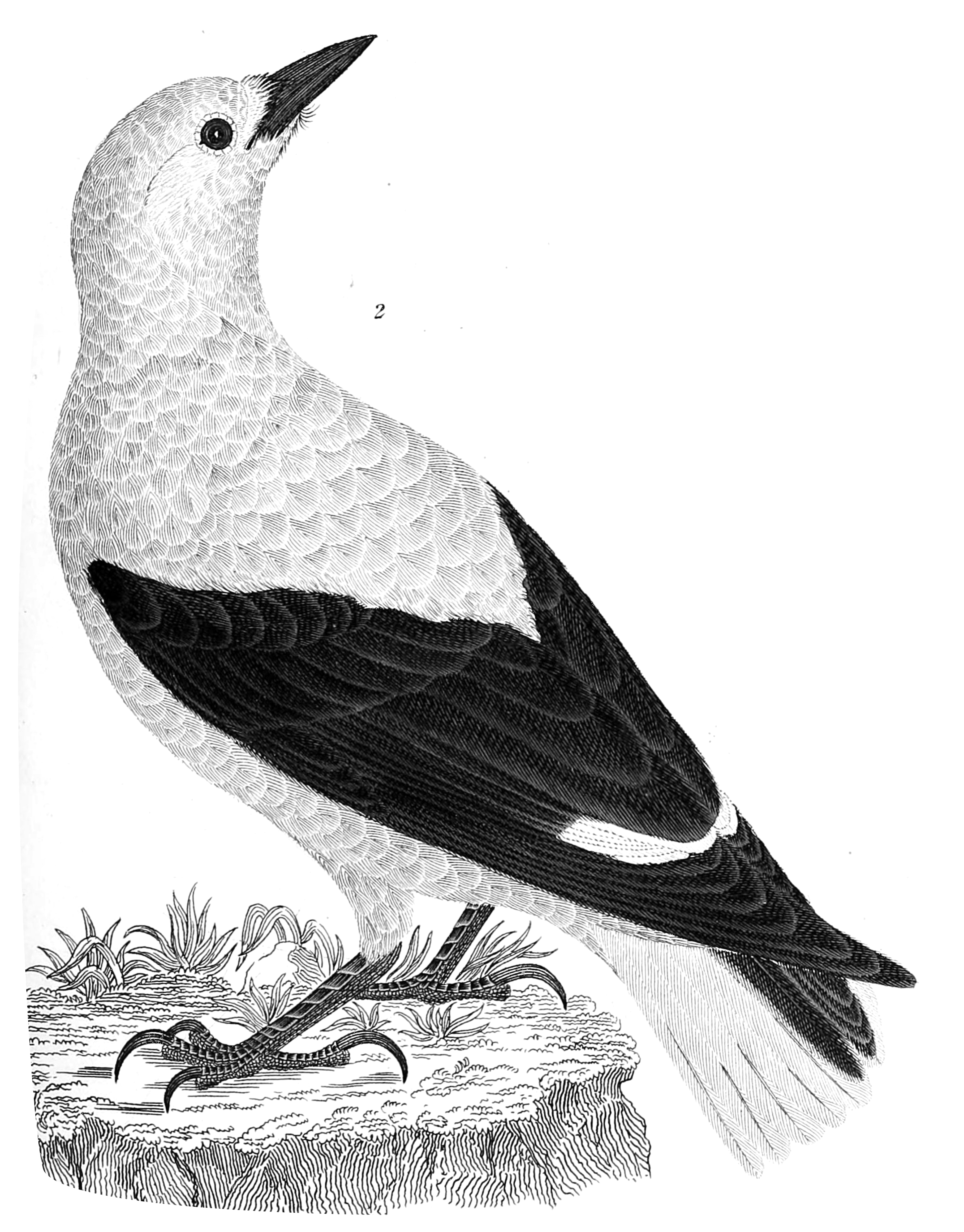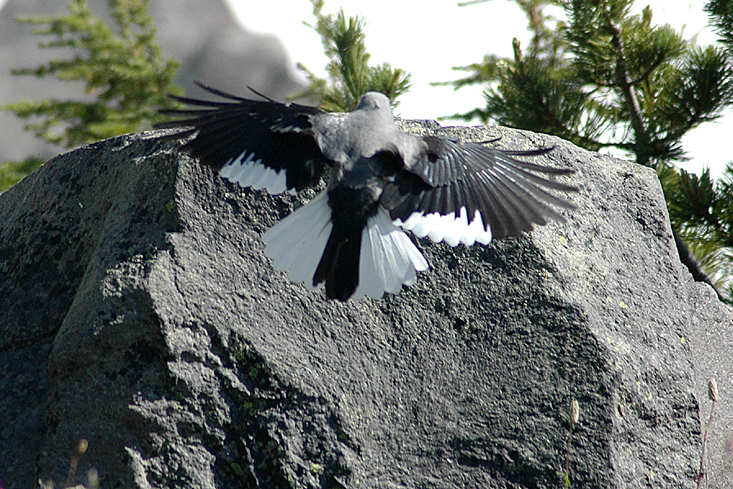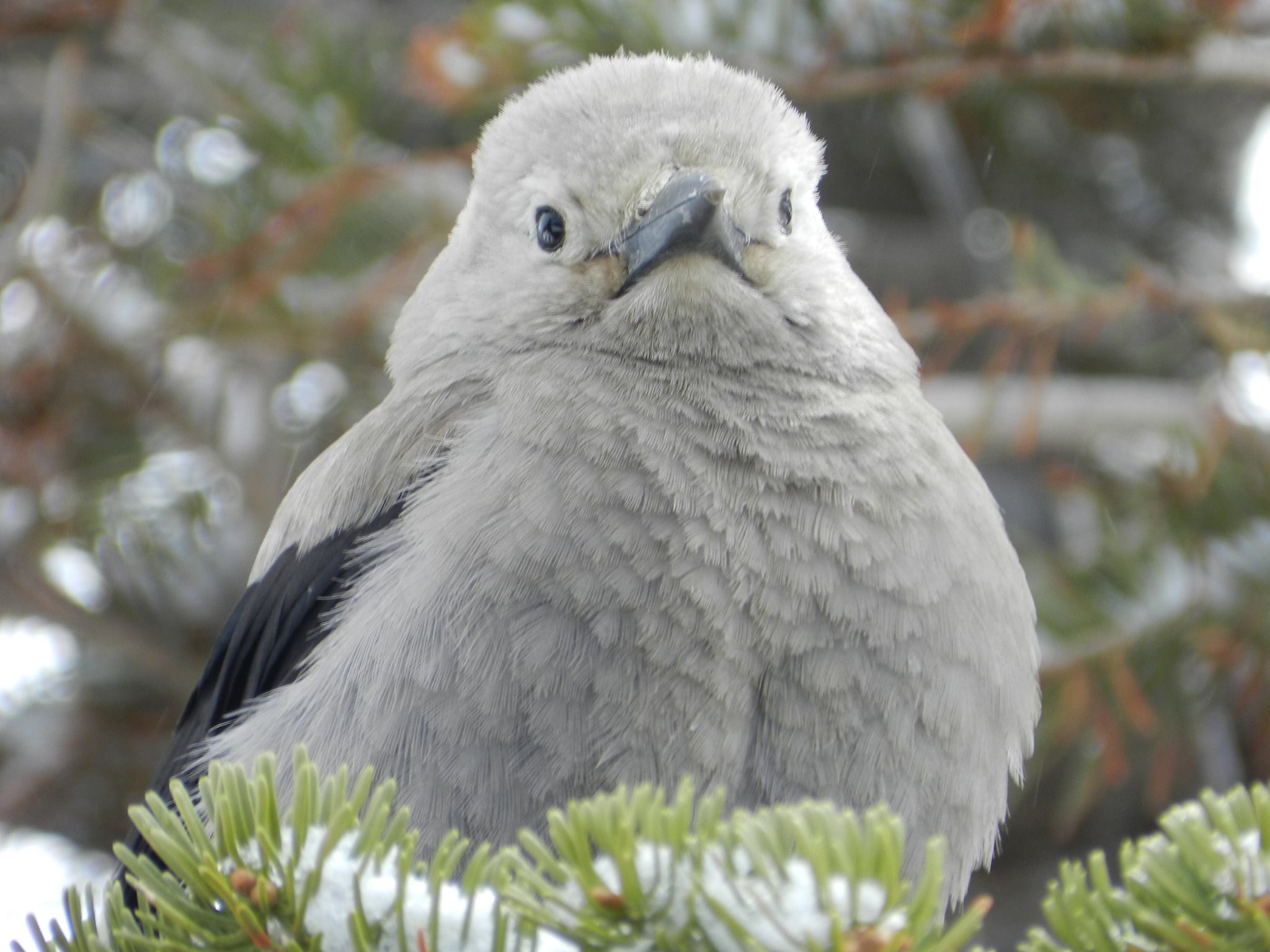Clark's nutcracker on:
[Wikipedia]
[Google]
[Amazon]
Clark's nutcracker (''Nucifraga columbiana''), sometimes referred to as Clark's crow or woodpecker crow, is a

 The diet also includes a wide range of
The diet also includes a wide range of
 The species usually nests in pines or other types of conifers during early spring. Two to four eggs are laid, incubation usually occurring in 16–18 days. Incubation is performed by both the male and female parents, and both the male and the female develop brood patches. The young are typically fledged by around the 22nd day. The fledglings follow their parents around for several months, possibly in order to learn the complex seed storage behavior.
The species usually nests in pines or other types of conifers during early spring. Two to four eggs are laid, incubation usually occurring in 16–18 days. Incubation is performed by both the male and female parents, and both the male and the female develop brood patches. The young are typically fledged by around the 22nd day. The fledglings follow their parents around for several months, possibly in order to learn the complex seed storage behavior.
NatureServe report
VIREO * ttp://ibc.lynxeds.com/species/clarks-nutcracker-nucifraga-columbiana Clark's nutcrackeron the Internet Bird Collection
Clark's nutcracker
at All About Birds
Whitebark Pine Ecosystem Foundation
{{Taxonbar, from=Q1142785 Clark's nutcracker Native birds of Western Canada Native birds of the Western United States Birds of the Sierra Nevada (United States) Birds of the Rio Grande valleys Fauna of the Chihuahuan Desert Clark's nutcracker Taxa named by Alexander Wilson (ornithologist)
passerine
A passerine () is any bird of the order Passeriformes (; from Latin 'sparrow' and '-shaped'), which includes more than half of all bird species. Sometimes known as perching birds, passerines are distinguished from other orders of birds by th ...
bird in the family Corvidae
Corvidae is a cosmopolitan family of oscine passerine birds that contains the crows, ravens, rooks, jackdaws, jays, magpies, treepies, choughs, and nutcrackers. In colloquial English, they are known as the crow family or corvids. Cu ...
, native to the mountains of western North America. The nutcracker is an omnivore, but subsists mainly on pine nuts, burying seeds in the ground in the summer and then retrieving them in the winter by memory.
Etymology and history
The bird was described by theLewis and Clark Expedition
The Lewis and Clark Expedition, also known as the Corps of Discovery Expedition, was the United States expedition to cross the newly acquired western portion of the country after the Louisiana Purchase. The Corps of Discovery was a select gr ...
, with William Clark
William Clark (August 1, 1770 – September 1, 1838) was an American explorer, soldier, Indian agent, and territorial governor. A native of Virginia, he grew up in pre-statehood Kentucky before later settling in what became the state of Miss ...
first observing it in 1805 along the banks of the Salmon River, a tributary of the Columbia River
The Columbia River ( Upper Chinook: ' or '; Sahaptin: ''Nch’i-Wàna'' or ''Nchi wana''; Sinixt dialect'' '') is the largest river in the Pacific Northwest region of North America. The river rises in the Rocky Mountains of British Columbia ...
. Its scientific name literally means "nutcracker of the Columbia." Lewis recorded a more detailed description in 1806. A skin collected by the expedition was obtained by the ornithologist Alexander Wilson, who used it to produce an engraving for his monumental ''American Ornithology''.

Taxonomy
Originally placed in the genus '' Corvus'' by Lewis, Clark's nutcracker was later included in ''Nucifraga'' by Wilson, which also includes two Old World species with similar lifestyles and habitats.Distribution and habitat
This species is present in western North America fromBritish Columbia
British Columbia (commonly abbreviated as BC) is the westernmost province of Canada, situated between the Pacific Ocean and the Rocky Mountains. It has a diverse geography, with rugged landscapes that include rocky coastlines, sandy beaches, for ...
and western Alberta
Alberta ( ) is one of the thirteen provinces and territories of Canada. It is part of Western Canada and is one of the three prairie provinces. Alberta is bordered by British Columbia to the west, Saskatchewan to the east, the Northwest T ...
in the north to Baja California
Baja California (; 'Lower California'), officially the Free and Sovereign State of Baja California ( es, Estado Libre y Soberano de Baja California), is a state in Mexico. It is the northernmost and westernmost of the 32 federal entities of Mex ...
and central New Mexico
)
, population_demonym = New Mexican ( es, Neomexicano, Neomejicano, Nuevo Mexicano)
, seat = Santa Fe, New Mexico, Santa Fe
, LargestCity = Albuquerque, New Mexico, Albuquerque
, LargestMetro = Albuquerque metropolitan area, Tiguex
, Offi ...
in the south. There is also a small isolated population on the peak of Cerro Potosí
Cerro El Potosí is the highest mountain in the Sierra Madre Oriental mountain range of northeast Mexico. It is located in the state of Nuevo León, about 80 km (50 mi) south of Monterrey.
Flora and fauna
It is composed of lime ...
, elevation 3,700 metres (12,200 ft), in Nuevo León
Nuevo León () is a state in the northeast region of Mexico. The state was named after the New Kingdom of León, an administrative territory from the Viceroyalty of New Spain, itself was named after the historic Spanish Kingdom of León. Wit ...
, northeast Mexico
Mexico (Spanish language, Spanish: México), officially the United Mexican States, is a List of sovereign states, country in the southern portion of North America. It is borders of Mexico, bordered to the north by the United States; to the so ...
. It is mainly found in mountains at altitudes of 900–3,900 metres (3,000–12,900 ft) in conifer forest. It is not migratory except in the sense of moving back and forth locally between areas of higher and lower elevation. Outside the breeding season, it may wander extensively to lower altitudes and also further east as far as Illinois
Illinois ( ) is a state in the Midwestern United States. Its largest metropolitan areas include the Chicago metropolitan area, and the Metro East section, of Greater St. Louis. Other smaller metropolitan areas include, Peoria and Rock ...
(and exceptionally, Pennsylvania
Pennsylvania (; ( Pennsylvania Dutch: )), officially the Commonwealth of Pennsylvania, is a state spanning the Mid-Atlantic, Northeastern, Appalachian, and Great Lakes regions of the United States. It borders Delaware to its southeast, ...
), particularly following any cone crop failure in its normal areas.
Description
''Nucifraga columbiana'' can reach an average length of . It is slightly smaller than itsEurasia
Eurasia (, ) is the largest continental area on Earth, comprising all of Europe and Asia. Primarily in the Northern and Eastern Hemispheres, it spans from the British Isles and the Iberian Peninsula in the west to the Japanese archipelag ...
n relative the spotted nutcracker (''N. caryocatactes''). Most of its body has feathers that are ashy-grey and loose in texture. The wings and tail are black and white. The central tail feathers are black and the outer ones white. The bill, legs and feet are also black. The bill is long, stout, and cone-shaped.
Measurements:
* Length: 10.6-11.8 in (27-30 cm)
* Weight: 3.7-5.7 oz (106-161 g)
* Wingspan: 24 in (61 cm)
Food
The most important food resources for this species are the seeds ofpine
A pine is any conifer tree or shrub in the genus ''Pinus'' () of the family (biology), family Pinaceae. ''Pinus'' is the sole genus in the subfamily Pinoideae. The World Flora Online created by the Royal Botanic Gardens, Kew and Missouri Botanic ...
s (''Pinus'' sp.), principally the two cold-climate (high altitude) species of white pine (''Pinus'' subgenus ''Strobus'') with large seeds '' P. albicaulis'' and '' P. flexilis'', but also using other high-altitude species like '' P. balfouriana, P. longaeva'' and '' P. monticola''. During migrations to lower altitudes, it also extensively uses the seeds of pinyon pine
The pinyon or piñon pine group grows in southwestern North America, especially in New Mexico, Arizona, and Utah. The trees yield edible nuts, which are a staple food of Native Americans, and widely eaten as a snack and as an ingredient in ...
s. The isolated Cerro Potosí population is strongly associated with the local endemic Potosi pinyon ''Pinus culminicola''. All Clark's Nutcrackers have a sublingual pouch capable of holding around 50–150 seeds, depending on the size of the seeds;Tomback, D. F. 1998. Clark's Nutcracker (''Nucifraga columbiana''). ''In'' A.Poole and F.Gill, editors. The Birds of North America, No. 331. The Birds of North America, Inc., Philadelphia. the pouch greatly enhances the birds' ability to transport and store seeds.
Clark's nutcrackers store seeds, usually in the ground for later consumption, in caches of 1–15 seeds (average of 3–4 seeds). Depending on the cone crop as well as the tree species, a single Clark's nutcracker can cache as many as 98,000 seeds per season. The birds regularly store more than they actually need as insurance against seed theft by other animals (squirrel
Squirrels are members of the family Sciuridae, a family that includes small or medium-size rodents. The squirrel family includes tree squirrels, ground squirrels (including chipmunks and prairie dogs, among others), and flying squirrels. ...
s, etc.), as well as low availability of alternative foods; this surplus seed is left in the cache, and may be able to germinate and grow into new trees, if the conditions are right. Through this activity of caching and over-storing, the bird is perpetuating its own habitat. Closely tied in with this storage behavior is the bird's remarkable long-term spatial memory; they are able to relocate caches of seeds with great accuracy, even nine months later, and even when the cache sites are buried under up to a meter (3 ft) of snow. Its powers of memory exemplify the high intelligence of the Corvidae. Clark's nutcrackers are known for storing a recovering large numbers of seed catches that are critical for winter survival. Short-term memory tasks reveal that nutcrackers can remember spatial information better than visual information. It was demonstrated that the catch recovery ability of Clarks nutcracker is derived from a memory system that has evolved differently for storing spatial information.
insect
Insects (from Latin ') are pancrustacean hexapod invertebrates of the class Insecta. They are the largest group within the arthropod phylum. Insects have a chitinous exoskeleton, a three-part body ( head, thorax and abdomen), three pa ...
prey, berries and other fruits, small mammal
Mammals () are a group of vertebrate animals constituting the class Mammalia (), characterized by the presence of mammary glands which in females produce milk for feeding (nursing) their young, a neocortex (a region of the brain), fur ...
s and occasionally flesh from carcasses. Eggs and nestlings are sometimes devoured, and peanut
The peanut (''Arachis hypogaea''), also known as the groundnut, goober (US), pindar (US) or monkey nut (UK), is a legume crop grown mainly for its edible seeds. It is widely grown in the tropics and subtropics, important to both small an ...
s and suet have become a favorite at bird tables. Food is taken both from the ground and from trees, where the nutcrackers are very agile among the branches. The birds are able to extract food by clasping pine cones in such a way that the cones are held between one or both feet. The birds then hack the cones open with their strong bills. Rotten logs are also hacked into in order to locate large beetle grubs, and animal dung may be flipped over in search of insects. Clark's nutcrackers can also be opportunistic feeders in developed areas, and are known to some as "camp robbers".
Nesting
 The species usually nests in pines or other types of conifers during early spring. Two to four eggs are laid, incubation usually occurring in 16–18 days. Incubation is performed by both the male and female parents, and both the male and the female develop brood patches. The young are typically fledged by around the 22nd day. The fledglings follow their parents around for several months, possibly in order to learn the complex seed storage behavior.
The species usually nests in pines or other types of conifers during early spring. Two to four eggs are laid, incubation usually occurring in 16–18 days. Incubation is performed by both the male and female parents, and both the male and the female develop brood patches. The young are typically fledged by around the 22nd day. The fledglings follow their parents around for several months, possibly in order to learn the complex seed storage behavior.
Whitebark pine mutualism
Clark's nutcracker is the primary seed disperser for whitebark pine (''Pinus albicaulis'').Tomback, D. F. 1982. Dispersal of whitebark pine seeds by Clark's Nutcracker: A mutualism hypothesis. Journal of Animal Ecology 51:451–467. Whitebark pine is in decline throughout its range, due to infection by white pine blister rust (''Cronartium ribicola''), widespread outbreaks of mountain pine beetle, and the long-term effects of fire suppression.Tomback, D. F., S. F. Arno, and R. E. Keane. 2001. Whitebark Pine Communities: Ecology and Restoration. Island Press, Washington, DC. The Clark's nutcracker is an integral part of the whitebark pine restoration process: the Clark's nutcracker must remain in whitebark pine forests and cache the seeds in excess, so that healthy trees will continue to grow. If whitebark pine declines into extinction, the Clark's nutcracker will lose an important source of food and may no longer be seen in areas where the tree is the primary source of seed, such as Glacier National Park.Vocalization
The voice of this bird is extremely varied and produces many different sounds. However, the most frequent call is commonly described as '.References
* Lanner, R. M. (1996). ''Made for each other: a symbiosis of birds and pines''. OUP. * Balda R., Kamil C., Linking Life Zones, Life History Traits, Ecology, and Spatial Cognition in Four Allopatric Southwestern Seed Caching Corvids, 200External links
VIREO * ttp://ibc.lynxeds.com/species/clarks-nutcracker-nucifraga-columbiana Clark's nutcrackeron the Internet Bird Collection
Clark's nutcracker
at All About Birds
Whitebark Pine Ecosystem Foundation
{{Taxonbar, from=Q1142785 Clark's nutcracker Native birds of Western Canada Native birds of the Western United States Birds of the Sierra Nevada (United States) Birds of the Rio Grande valleys Fauna of the Chihuahuan Desert Clark's nutcracker Taxa named by Alexander Wilson (ornithologist)